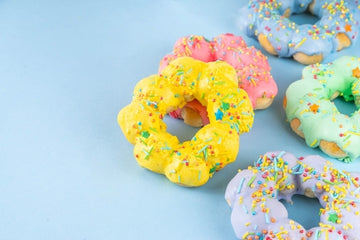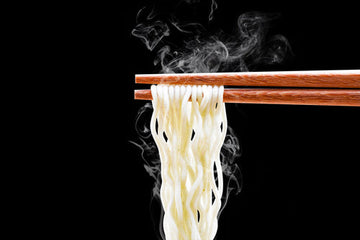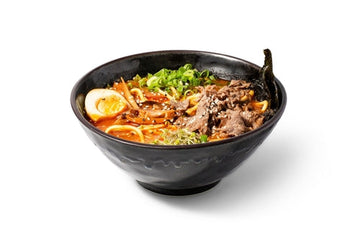Mochi donuts have become a sensation in recent years, captivating foodies with their chewy texture and unique flavors. Combining elements of Japanese mochi and traditional American donuts, these sweet treats are as fun to eat as they are Instagram-worthy.
Here’s everything you need to know about mochi donuts, from their origins to tips for making them at home.
The Origins of Mochi Donuts
Mochi donuts originated in Japan but gained popularity through Hawaiian influences. One of the most recognized pioneers of this delightful treat is the Japanese chain Mister Donut, which introduced the "Pon de Ring," a donut made with tapioca flour. Over time, bakers began experimenting with glutinous rice flour (mochiko) to create a chewier, more mochi-like texture. Today, mochi donuts are beloved worldwide for their fusion of cultural elements and irresistible taste.
What Makes Mochi Donuts Unique?
Mochi donuts stand out due to their texture and appearance. Unlike traditional donuts, mochi donuts are made with mochiko or other glutenous rice-based flours, resulting in a chewy, slightly bouncy bite. Their signature look is often a ring of small, connected balls, making them easy to pull apart and share. They are also lighter than traditional donuts, with a crispier exterior and a softer interior.
The customizable nature of mochi donuts also adds to their appeal. From classic glazes to innovative toppings, the possibilities are endless.
How Mochi Donuts Are Made
The process of making mochi donuts combines traditional baking with unique ingredients. Here’s a simplified breakdown:
- The Base: Mochiko flour serves as the key ingredient, providing the chewy texture. It's often mixed with sugar, eggs, and milk to create a dough.
- Shaping: The dough is shaped into small balls and arranged in a circular mold to form the characteristic ring shape.
- Frying: Mochi donuts are typically deep-fried to achieve a golden, crispy exterior while maintaining a soft, chewy interior.
- Glazing and Toppings: Once fried, the donuts are coated with glazes like matcha, chocolate, or fruity flavors. Toppings like sprinkles, crushed nuts, or coconut flakes add extra flair.

Popular Flavors of Mochi Donuts
Mochi donuts come in a variety of exciting flavors. Some of the most popular include:
- Matcha: A classic Japanese green tea glaze that offers a balance of sweetness and earthy bitterness.
- Taro: A vibrant purple glaze with a subtle, nutty flavor.
- Black Sesame: Nutty and aromatic, with a striking charcoal-gray appearance.
- Mango or Passionfruit: Fruity and tangy options for a tropical twist.
- Cookies and Cream: A crowd favorite with crushed cookie bits on top of a creamy glaze.
Seasonal flavors, such as pumpkin spice or peppermint, often appear around holidays, adding to their year-round charm.
Mochi Donuts vs. Traditional Donuts: Key Differences
While mochi donuts and traditional donuts share similarities, they differ in several key ways:
- Texture: Mochi donuts have a chewy, elastic texture compared to the soft, fluffy texture of traditional donuts.
- Ingredients: Mochiko flour replaces the standard wheat flour in mochi donuts.
- Shape: Mochi donuts often have the signature "pon de ring" shape, while traditional donuts come in rings, holes, or filled varieties.
- Taste: Mochi donuts are lighter and less sweet, making them a versatile option for both dessert lovers and those who prefer less sugary snacks.
Where to Find the Best Mochi Donuts Near You
Mochi donuts can now be found in many specialty bakeries and cafes around the world. Some popular options include:
- Local Japanese or Asian bakeries: Many traditional Japanese bakeries offer authentic versions of mochi donuts.
- Fusion cafes: Modern cafes that specialize in trendy desserts often have creative takes on mochi donuts.
- Food trucks and pop-ups: Keep an eye out for mochi donut food trucks or weekend pop-ups in your area.
If you're unable to find them locally, many bakeries offer online ordering and nationwide shipping.
Are Mochi Donuts Gluten-Free?
Since mochi donuts are primarily made with mochiko flour, which is naturally gluten-free, they can be a great option for those avoiding gluten. However, cross-contamination and additional ingredients like wheat flour in some recipes may make certain varieties unsuitable for gluten-sensitive individuals. Always check with the bakery or recipe source to ensure the donuts meet your dietary needs.
Tips for Making Mochi Donuts at Home
Want to try your hand at making mochi donuts? Here are a few tips to get started:
The Secret Ingredient: Mochiko Flour
Mochiko flour is the cornerstone of mochi donuts. This sweet rice flour provides the distinct chewy texture and ensures the donuts hold their shape during frying. Be sure to use high-quality mochiko flour for the best results.
Trending Mochi Donut Recipes
Experimenting with trending recipes can be a fun way to personalize your mochi donuts. Consider trying:
- Vegan mochi donuts: Use plant-based milk and egg substitutes for a dairy-free and egg-free option.
- Air-fried mochi donuts: Skip the deep fryer and opt for an air fryer for a healthier alternative.
- Fusion flavors: Combine international flavors like salted caramel or Thai tea glaze.
Why Mochi Donuts Have Taken Social Media by Storm
The photogenic appearance of mochi donuts, coupled with their unique texture and flavors, makes them a social media favorite. From their pastel glazes to creative toppings, they are a treat for both the palate and the camera.
Pairing Mochi Donuts with Beverages
Pair your mochi donuts with complementary beverages for a complete snack experience. Matcha lattes, jasmine tea, or even bubble tea enhance the flavors and add a refreshing element.
Visit Us for Freshly Made Mochi Donuts
Mochi donuts are more than just a dessert—they’re a cultural and culinary experience. Whether you try them at a local bakery, order online, or make them at home, their chewy texture and vibrant flavors are sure to win you over. Contact us today to enjoy the freshest, most delicious mochi donuts around!






